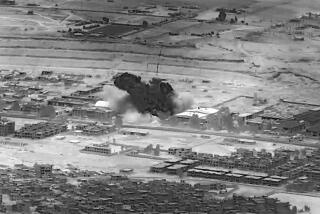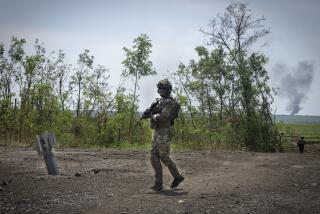U.S. Poised to Engulf the Capital
- Share via
WASHINGTON — With a powerful drive through Iraqi lines south of Baghdad, U.S.-led forces have reached an important milestone in their 2-week-old war: They are now positioned to encircle and gradually destroy the Republican Guard troops ringing the city.
The piercing Wednesday of a front line 50 miles south of the capital came days sooner than some American commanders had predicted. It demonstrates that, under the pounding of U.S. aircraft and ground forces, the Iraqis are losing the ability to protect themselves by maneuvering or going to ground.
In a new phase now unfolding, U.S.-led forces will fan out around the outskirts of Baghdad, a city of 5 million. They will continue to bomb and shell President Saddam Hussein’s forces in hopes of killing large numbers of troops before the Iraqis can retreat into the city streets for a final fight.
The key decision for U.S. war planners now is how long to wait before mounting a final assault.
With their supply lines better protected, U.S. forces can take their time, and even have the option of waiting several weeks for armored reinforcement units before attacking the city.
Yet the Iraqis, with their backs to the wall, still have options. They might mount the kind of counterattack that the Republican Guard used skillfully during the 1980-88 Iran-Iraq war to turn the tide of battle.
American officials believe that the Iraqis might choose this moment to resort to any banned chemical weapons they might possess. And they might still be able to draw U.S. forces into the kind of bloody urban fight that would be the Iraqis’ best hope of inflicting large numbers of casualties and drawing out the war.
“We are expecting ... a very difficult fight ahead,” Army Maj. Gen. Stanley A. McChrystal, vice director of operations for the Joint Chiefs of Staff, said at the Pentagon.
Some military officials had forecast that it could take Army and Marine units a week or more to punch through the 100-mile-long southern line between the cities of Karbala to the southwest of Baghdad and Al Kut to the southeast. But the Medina and Baghdad divisions of the Republican Guard were staggered over the last four days by assault from warplanes, attack helicopters, artillery and rockets.
Army officials had spoken of their concern that 3rd Infantry Division troops could be pounded by Iraqi artillery as they threaded their way through the narrow Karbala Gap, between Razzaza Lake and the Euphrates River. But when they pushed through it on Tuesday’s moonless night, they found little resistance.
On Wednesday, some troops were 20 miles from Baghdad, whose skyline was in sight.
“They thought the fight was going to last a week, and the bulk of it was over in hours,” said Michael Vickers, a former CIA and Special Forces officer now at the Center for Strategic and Budgetary Assessments in Washington.
The 1st Marine Division also met little resistance as it sped north of Al Kut, past the charred equipment of much of the Baghdad Division.
In small towns scattered between the Euphrates and Tigris rivers, the Iraqis had sought to protect their forces behind earthen mounds, under trees and near civilians. But in clashes in several towns, U.S. forces found them and took advantage of their stationary position to destroy them with tanks and other heavy equipment.
Other Iraqi units stayed in motion. But they were often spotted from the air and pounded.
One military official speculated that the Republican Guard divisions deployed south of Baghdad might be down to 30% of their fighting strength -- an estimate reached by the amount of heavy equipment knocked out of action. Military officials usually regard units that have less than 50% of their strength as unable to take part in battle.
The U.S. attacks battered not only the Medina and Baghdad divisions but also portions of the Hammurabi, Al Nida and Nebuchadnezzar divisions that were sent as reinforcements.
The Iraqis sent reinforcements south in armored pickup trucks mounted with .50-caliber machine guns, perhaps in hopes that they would be too small to be seen from the air. But U.S. forces spotted, and struck, several of these convoys, Vickers said.
Daniel Goure, a former Pentagon official who is now an analyst at the Lexington Institute, estimated that the Republican Guard might already have lost half of its strength of 80,000 troops and 800 tanks.
U.S. forces have not yet spotted any large flow of troops fleeing from the front into the city.
If a large retreat does begin, U.S. forces can bombard the Iraqis with aircraft that are designed for ground strikes, including the low-flying A-10 Warthog, used for destroying tanks, and AC-130 gunships. They also might drop troops of the 101st Airborne, now deployed southwest of Baghdad, to seize ground near the entrances to the city and cut off the retreat.
A retreat under the continuing U.S. bombardment “would be a very hazardous undertaking,” Army Brig. Gen. Vincent Brooks of the Central Command told reporters in Qatar on Wednesday.
U.S. officials say they are hoping that a flow of demoralized troops might hasten a full collapse of the regime. Indeed, they have signaled that they might delay their attack on the city if there were signs that such a collapse was imminent.
Yet despite the damage they have suffered, the Iraqis have several ways to strike back.
Although no chemical weapons have yet been found during the campaign, U.S. officials worry that Hussein’s forces have hundreds of artillery shells with chemical warheads carrying deadly nerve agents, as well as surface-to-surface missiles and multiple-rocket launchers. U.S. forces have made special efforts to find and blow up such launchers in recent days because of concerns that they could be used to hurl chemical shells at American-led troops before or during a final push.
To inflict casualties, the Iraqis might mount terrorist-style attacks on troops in the rear -- they might try, for example, to blow up some of the hundreds of fuel tanker trucks that have accompanied U.S. forces.
The Iraqis could also regroup and mount a conventional counterattack. The Republican Guard won respect for its ability to conduct such assaults during the war with Iran, and U.S. officials say the Iraqis have a number of skilled generals.
But if the Iraqi commanders concentrate their forces, the troops become easier targets for U.S. aircraft to destroy with precision munitions or even with huge loads of unguided “dumb” bombs.
U.S. intelligence officials also have warned that Hussein’s loyalists, including his thousands of security police and Fedayeen Saddam paramilitary fighters, could regroup to fight on as a guerrilla force.
Iraqi leaders have continued to warn in recent days that the American-led forces can never conquer Baghdad. They vow that a fight in the city will inflict thousands of U.S. casualties.
U.S. war planners believe that they can break the regime without widespread house-to-house fighting -- by knocking out key targets, such as leadership posts, supply depots and communications centers, by air or with brief raids.
In any event, without a threatening force coming at them from another part of the country, or any threat to their supply lines, the U.S. forces can consider their next step carefully.
“They’ve gained the luxury of time,” Goure said.
More to Read
Sign up for Essential California
The most important California stories and recommendations in your inbox every morning.
You may occasionally receive promotional content from the Los Angeles Times.














